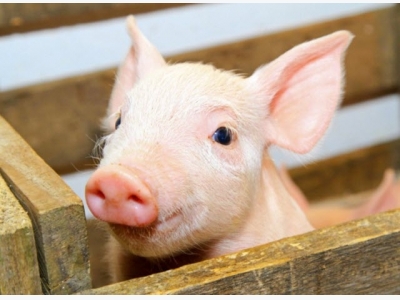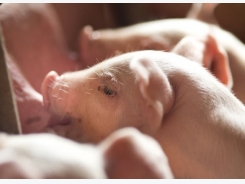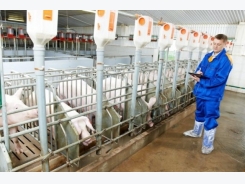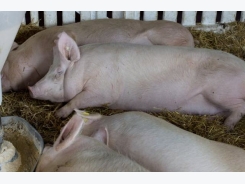Organic acid blends enhance growth performance in piglets: study

© istock
An international team of researchers saw positive effects from mixed organic acids in the diet on performance, serum immunity, intestinal morphology and microbiota in the weaned piglets.
The team published the findings in the journal of Animal Feed Science and Technology.
The researchers said weaned piglets are exposed to various multiple stressors, including changes in diet composition, surrounding environment, and microbial challenges. Such stressors can result in digestive upset, depression and retardation of performance and even a death if it is severe, they added.
In-feed antibiotic growth promoters (AGP) have been widely used for reducing harmful microbial activity and gastrointestinal disease in weaned piglets. However, AGP usage has been banned in the EU since 2006 and there is increasing pressure for stricter regulations in North America and elsewhere. Research into substitutes continues.
Nutrient digestibility
The authors cited a large number of studies showing the benefits of organic acids (OA) in enhancing growth performance and nutrient digestibility coincident with modulating intestinal microbiota for piglets and broilers (Namkung et al., 2004; Abdelqader and Al-Fataftah, 2015), noted the authors.
Research from Partanen and Mroz, 1999; Morz et al., 2000; Creus et al., 2007 indicated formic acid and its salts are found to reduce pH of the gastrointestinal tract and thereby enhance the activity of digestive enzymes, they said.
Another study showed formic acid has strong bacteriostatic effects and increases average daily gain (ADG) by 14% in weaned piglets (Tsiloyiannis et al., 2001), said the team.
They said butyric acid (BA) and its salts also provide a positive impact on growth performance, morphology of intestinal mucosa and feed digestibility, although the authors said studies indicated BA decreased feed intake due to its odor (Gálfi and Bokori, 1990; Piva et al., 2002; Kotunia et al., 2004).
The authors also noted that Partanen et al. (2007) reported pigs fed with 0.6% mixed OA improved ADG, and a study evaluating a blend of formic acid and lactic acid show positive effects on improving feed efficiency (Partanen and Mroz, 1999).
Lee et al., 2007 showed a blend of medium chain fatty acids (MCFA) and short chain OA can be used by enterocytes as energy source and can attenuate negative effects of weaning on villus length and crypt depth in piglets.
However, they said the action mechanism of mixed OA is not clear (Guilloteau et al., 2010):
“It could be due to the effects of different OA at different sites in the gastrointestinal tract (Franco et al., 2005; Kasprowiczpotocka et al., 2009).”
Method
The objective of the study was to determine the effect of two OA blends products, as a replacement for AGP, on performance, nutrient digestibility, serum immunity, intestinal morphology and microbiota in newly weaned pigs.
A total of 144 weaned piglets, with average weight 8.63 ± 1.56 kg, were randomly allocated to one of four dietary treatments with six replicate pens per treatment - 3 barrows and 3 gilts per pen.
The dietary treatments included:
A corn-soybean basal diet (CTR)
An AGP diet consisting of CTR + 10 mg/kg zinc bacitracin, 5 mg/kg colistin sulphate and 5 mg/kg olaquindox
An organic acid 1 diet (OA1) comprising CTR + 3000 mg/kg OA1- a synergistic blend of free and buffered short chain fatty acids - mainly formic acid, acetic acid and propionic acid combined with medium chain fatty acids (MCFA)].
Organic acid 2 diet (OA2) comprising CTR + 2000 mg/kg OA2 - a synergistic blend of a phenolic compound, slow release C12, target release butyrate and sorbic acid, MCFA and OA.
Results
Compared with CTR, the researchers said they found the average daily gain (ADG) and feed efficiency (FE) were improved by OA2 in phase 2 (d 14–28) and the overall period (d 0–28), while OA1 improved FE during the overall period.
The AGP diet increased ADG and FE in phase 2.
Both OA1 and OA2 reduced the incidence of diarrhea and fecal E. coli counts, they added.
The apparent total tract digestibility (ATTD) of total carbohydrates, neutral detergent fiber (NDF), acid detergent fiber (ADF) and phosphorus was improved by OA2 in phase 1 (d 0–14), said the Chinese team.
In phase 2, OA1 increased ATTD of dry matter, total carbohydrates, NDF and ADF while OA2 improved ATTD of total carbohydrates, phosphorus and ether extract, they noted.
The concentration of total volatile fatty acid in feces was improved in pigs supplemented with AGP, OA1 and OA2 compared with the CTR diet, said the researchers.
"The concentration of IgG, growth hormone, and total antioxidant capacity in serum tended to be higher, and the amount of hydroxyl radicals in serum was lower in pigs supplemented with OA2 compared with CTR."
Crypt depth in the jejunum for piglets fed with OA2 was lower and the ratio of villus height to crypt depth in the jejunum and ileum was greater in pigs fed with AGP, OA1 or OA2 than those of CTR, they said.
“The present research demonstrated that overall growth performance was improved in pigs fed diets supplemented with mixed OA when compared with CTR and were similar to pigs fed with AGP diet.
“The results could be due to the improvement in ATTD of DM, ether extract (EE), total carbohydrates, NDF, ADF, phosphorus and intestinal morphology by mixed OA supplementation. In addition, the lower E. coli content in feces and health status measured by decreased diarrhea score and increased immune indices together with antioxidant indices.
“Results suggested that Organic acid 1 or Organic acid 2 can be used to replace AGP based on the positive effects on performance, serum immunity, intestinal morphology and microbiota in the weaned piglets,” said the researchers.
Related news
Tools

Phối trộn thức ăn chăn nuôi

Pha dung dịch thủy canh

Định mức cho tôm ăn

Phối trộn phân bón NPK

Xác định tỷ lệ tôm sống

Chuyển đổi đơn vị phân bón

Xác định công suất sục khí

Chuyển đổi đơn vị tôm

Tính diện tích nhà kính

Tính thể tích ao




 Delayed weaning could boost gut development, immune health…
Delayed weaning could boost gut development, immune health…  Energy digestibility differs in sows, gilts
Energy digestibility differs in sows, gilts